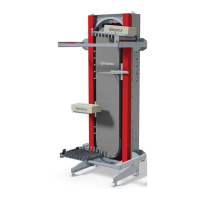UM-PRORUNNER_Mk5-1.2-EN-US 35
Description
Requirements for the product carrier
The product carrier must be mounted correctly
on the carrier axis.For a mounting example
refer to the instructions for the mounting
carrier. The product carrier must provide stable
support for the product during pick up and
movement. During the pass through of circular
movement, horizontal accelerations occur. The
product carrier must be strong enough to
capture the static and dynamic forces in order
to prevent damage to the product and parts of
the machine. During the pick up of a product a
peak load occurs. The stiffness of the product
carrier along with the product weight, product
geometry, and the speed of the carrier
determines the height of the peak load. To
reduce peak loads, place resilient materials between the product and the product carrier.
The center of gravity of the product carrier must be on the centerline of the leveler. The
center of gravity of the product must be about the vertical surface through the carrier axis.
Calculation of the product carrier
The maximal permitted load on the carrier axis is limited by the strength of the carrier axis.
The forces on the carrier axis are determined by the weight of the carrier, the weight of the
product, and acceleration forces during pick up of the product. The forces during pick up of
the product can be considered as a collision of the product with a resilient carrier, and then
make an estimation of the maximal force that occurs.The carrier axis can be considered as
a layer with support points on both ends and is loaded by a force and a moment. This
calculation can be checked by Qimarox on request.
4.3.3 Specification of gap between conveyors
The maximum allowed gap (A) between supply
/ output conveyor and infeed / outfeed
conveyor is 25 mm.

